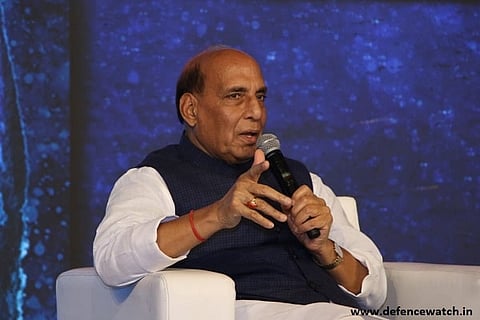
- News Updates
- PSU Watch
- Defence News
- Policy Watch
- हिन्दी न्यूज़
- Jobs Watch
- States News
- Event News

New Delhi: Union Defence Minister Rajnath Singh has said on Saturday that the first four Rafale jets are arriving in India by the last week of May, after which one aircraft will arrive every 45 days. Speaking at the Economic Times Global Business Summit, Singh said that the 36 jets will be enough to take care of adversaries as of now.
While one squadron of the Rafale fighter jets will be based in Ambala, the other would be in Hasimara, West Bengal. The Rafale jets, being manufactured by France-based Dassault Aviation, are twin-engine multi-role fighter aircraft. These are nuclear-capable and can engage in both air-to-air and air-to-ground attacks.
India has also started manufacturing parts for Rafale, some of which could even be used on the 36 French fighter jets. The Nagpur facility of Dassault Reliance Aerospace Limited (DRAL) was initially making only cockpits for the French OEM (Original Equipment Manufacturer).
Singh also called for increased participation of the private sector in defence manufacturing to realise the government's vision of making India a $5 trillion economy by 2024. In his address at the Global Business Summit, the minister said that the manufacturing sector has the potential to reach $1 trillion by 2025 and the government is striving to achieve the goal by implementing key flagship programmes like 'Make in India', besides building policies relevant to the digital-economy and fostering human-capital.
Urging the defence industry to make best use of the emerging opportunities, Singh said that a slew of structural reforms has been taken by the government to create increased synergy between the industry and the public sector to overcome the challenges of private investment in defence. He listed out several steps taken under the 'Make in India' initiative, including greater scope for domestic industry in defence tenders, simplification of the industrial licensing process, hike in FDI cap, making defence export less stringent, streamlining the defence offset policy, opening the government-owned trial and testing facilities for the private sector; setting up of two defence industrial corridors and promotion of innovation through participation of start-ups and small and medium enterprises.
"In our envisaged Defence Production Policy, we have clearly spelt out our goal to achieve a turnover of $26 billion in aerospace and defence goods & services by 2025. This will have huge implications for India's endeavours to promote R&D, innovation and its efforts to secure a place in global supply chains," Rajnath Singh said. He added that the necessity of becoming internationally competitive, globally innovative and structurally efficient demands that the private sector plays a crucial role in defence production.
Singh underlined that while the primary aim of defence production is to cater to the needs of the Armed Forces, thrust is also being given on enhancing exports. He said that Defence Public Sector Undertakings have been encouraged to increase their export portfolio to 25 percent of their turnover and the government is willing to extend Lines of Credit and grants to friendly foreign countries over the next five years. "The government aims to achieve exports of defence goods & services to the tune of $5 billion in next five years. All possible support would be extended to the private sector so that they can contribute significantly to enable us to achieve the said target," he added.
